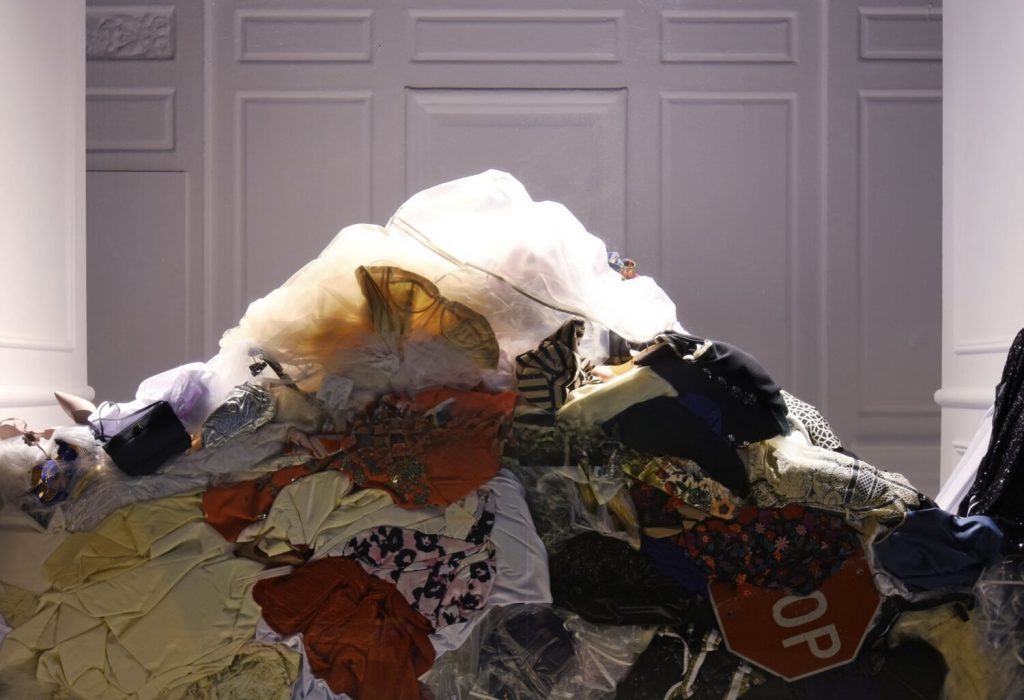The enactment of a French law that prohibits the destruction of unsold goods (namely, non-food products) is forcing brands to look more carefully at the volumes they are producing in order stay within the bounds of the law, while also avoiding the excessive markdowns that they view as a death knell to their luxury positioning. First passed back in early 2020, the “Projet de loi relatif à la lutte contre le gaspillage et à l’économie circulaire” – or Bill on the fight against waste and the circular economy – subjects companies to an array of new sustainability-centric mandates, such as those that require the systematic phasing out of automatic paper receipts and single use plastic in fast food restaurants and a ban on plastic packaging on most fruit and vegetables, followed by the outright ban on all single-use plastics by 2040.
Of particular relevance for the fashion industry is the prohibition on the destruction of an array of different types of unsold goods, including garments and accessories. To be exact, the law – which was formally approved by the French Sénat in January 2020, and formally put into effect on January 1, 2022 – aims to require producers, importers and distributors to refrain from destroying unsold goods. The fashion industry has been a particular target of the legislation, according to French legislators, who have noted that “apparel retailers, in particular, renew their products more frequently [than other industries] and often have surplus unsold stock.” Mass-market fashion companies and luxury brands, alike, have been tied to the practice of destroying unsold merchandise to avoid selling it at a discount and/or paying to store it, and as a way to avoid cross-border costs in some cases and to benefit from the “drawback” of certain duties in others.
Leading up to the passage of the unsold goods law, the French government asserted that apparel and accessories companies were among some of the notable culprits in terms of the more than 650 million euro (nearly $740 million) worth of new consumer products that are destroyed or disposed of on an annual basis in France, and the $900 million more worth of unsold items going to landfills.
(As for applicability, the law governs “producers,” a term that is defined by Article L. 421-1 of French Consumer Code as: “(a) manufacturer of the product (when it is established in the European Union) and any persons who present themselves as manufacturers by affixing their names, trademarks or other distinctive signs on the product, or any repairer of the product, (b) manufacturer’s representative (when the manufacturer is not established in the European Union) or the importer of the product (in the absence of a representative established in the European Union), and (c) any other professionals in the marketing chain, in so far as their activities may affect the safety characteristics of a product.”)
(With applicability in mind and just to play devil’s advocate for a moment, it is worth asking how effective this law will be given that luxury brand’s biggest markets (i.e., the markets where they offer up/sell the most products, and thus, likely manufacture and/or ship the largest quantities of their products to) are the U.S. and China, which maintain no such bans on destruction.)
In terms of how significantly the law is expected to impact brands, it may not necessarily be as striking as it seems. Product destruction has not only fallen out of favor in light of consumer concerns about Environmental, Social, and Governance elements, but for some time, no shortage of brands have adopted other methods for dealing with excess stock that still enables them to still generate revenue from it. As TFL has previously reported, no small number of brands have opted to quietly sell off merchandise to retailers like T.J. Maxx and online equivalents, or have turned a blind eye when their authorized retailers do so in order to generate revenue for unsold products at the end of a season.
Traditionally, brands have “tolerate[d] grey market activity for the sake of making their short-term results better,” Bernstein analyst Luca Solca stated back in 2018, putting the figure for these out-of-channel sales at “5 to 10 percent” of annual revenue for many fashion brands. However, attitudes towards the sale of branded goods outside of companies’ unauthorized distribution channels have started to change, as they look to regain some of the control that has been ceded with the rise of the global e-commerce market and potentially, the burgeoning luxury resale segment, as well.
At the same time, brands have pulled way back when it comes to discounting of unsold products, as seen in brands’ practice of touting increases in full-price sell-throughs. Late last year, Ralph Lauren revealed that it had decreased its reliance on off-price sales, and is focusing on its own retail sales – over wholesale and off-price avenues. A rep for the company confirmed, saying that it has “‘significantly reduced’ the amount of inventory it is sending to discount chains.” Other companies like Armani have boosted prices and said they have reduced the volumes of their output. “We have taken out things that traditionally do not sell,” Giorgio Armani said in an interview last spring. In addition to serving as a potential boon from a bottom-line perspective, Mr. Armani emphasized that “this will have a wider impact on the environment.”
What Now?
Where does the current state of things leave brands that do not want to face off against the French government and the relatively newly-implemented law that bans the destruction of unsold goods? LVMH’s environmental development director Helene Valade told AFP that while “the luxury business model is closely adjusted to demand,” the new law is, nonetheless, pushing luxury brands “to learn more about their clients to better anticipate their purchases and reduce stocks to a minimum.”
Enduring supply shortages and increased willingness among consumers to shell out following periods of lockdown have likely had a hand in helping to reduce output and supply, respectively. In December, Chanel’s president of fashion Bruno Pavlovsky, for one, said the brand did “not have enough products – especially for handbags.” Meanwhile, Valade – pointing to versions of Loewe bags – said that LVMH brands are seeing more products, namely leather goods, that are out of stock than in excess.
In the event that there is unsold inventory, AFP has stated that “selling products to staff at lower prices is one option,” particularly for the likes of LVMH, Kering, and other fashion groups that have large workforces.
Beyond that, two avenues seem like obvious options – and neither one necessarily forces brands to overtly chip away at their (hard-earned and marketing-heavy) luxury positioning. Primarily: Brands might be wise to utilize the resale market in a more strategic way in order to move excess merch. Secondary market efforts could provide brands with an additional point of access to entry-level luxury spenders in much the same way as more accessible, lower-priced products do. Greater activity by brands in this arena would give them the ability to more closely control the products that are being offered up and the conditions of those sales. And of course, in-house resale efforts and/or partnerships with established resale players could enable brands to somewhat discretely get rid of unsold stock without having to slap slashed price tags on their wares in stores.
Should brands aim to make bigger moves to own the resale space, they could sell off unsold goods alongside products that they buy-back from retailers (at the end of the season to avoid deep discounts there) and/or from consumers in something of the same way as resale platforms do. Not exactly novel territory, the melding together of pre-owned goods and close-out pieces is already happening in the secondary market. In addition to catering to consumers who wanted to consignment pre-owned products, The RealReal has been working with brands and retailers to off-load unsold apparel and accessories for several years, hence, all of the “new with tags” merch. Seemingly doubling down on this B2B element of its business, a rep for The RealReal previosuly told TFL that the resale giant had seen “a 30 percent increase in supply from brands in the six weeks to April 14, 2020 compared with the same period a year earlier.”
More recently, The RealReal President Rati Levesque noted that the vendor side of things is “a driver for high value for us,” namely, by way of “fine jewelry, watches, [and] handbags,” and says that the company expects to “continue to see that trend for the holiday.”
Another option for brands comes in the form of branded subscriptions boxes, a category that has been ramping up, as indicated by the investment by LVMH’s Luxury Ventures in Heat, the mystery box company that acquires unsold inventory from fashion brands – from Off-White to Balenciaga – and offers them up to consumers.
Finally, donation is an option, as well. As set out by the French law, for unsold basic goods, companies will be required to allow their use, including by donating them to specifically accredited associations that can ensure such products are utilized by an end customer in accordance with their purpose. It is, of course, difficult to imagine that brands will be quick to offload products with their branding on them in this way.
In light of enduring overproduction issues and budding legislative attempts to stomp out waste, the fashion industry is seeing the enduring rise of start-ups – such as Heat, materials resale platform Nona Source, and Trove, which partners with brands to create online platforms for them to sell used goods – that seek to assist companies with reducing their waste and dealing with unsold inventory. Efforts like these and others will likely continue to proliferate, and not just because of the French law, which may expose companies to financial penalties and the potential for the regulatory body in charge of the protection of competition and consumers to publish any infractions online or in the press at the expense of the company being fined, which could expose the offender to substantial reputational damage, particularly as sustainability initiatives continue to prove important to consumers across the globe.
Chances are, the French anti-destruction law may be the first of more legislation, as consumers, investors, and regulators, alike, continue to pay attention to companies’ workings when it comes to the environment and demand more transparency and in some cases, action.











